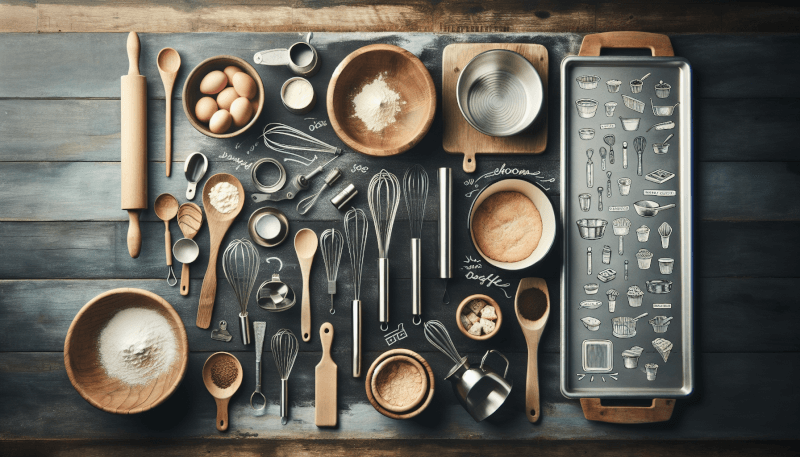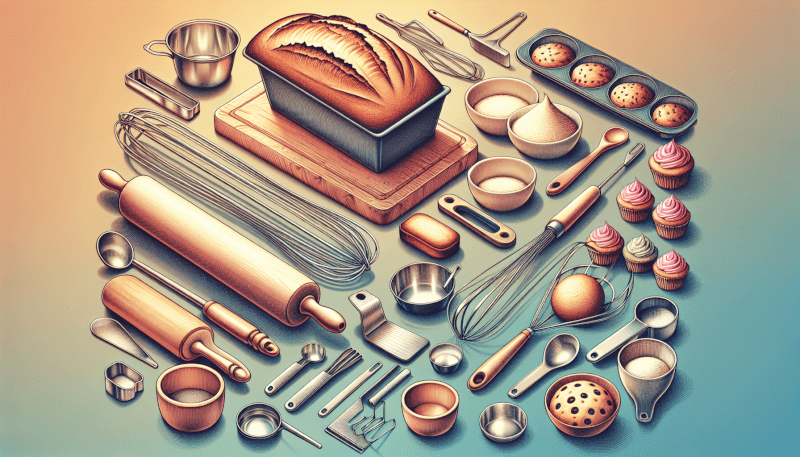Have you ever wondered why using the right baking utensils is crucial for baking projects? Well, in the world of baking, having the appropriate tools can make all the difference in the outcome of your delicious creations. From measuring cups to mixing bowls, each utensil plays a vital role in ensuring that your baked goods turn out just right. In this article, we will explore the importance of using the right baking utensils and how they can elevate your baking experience to a whole new level. So grab your apron and get ready to discover the secrets behind successful baking!

Prevent Contamination and Foodborne Illness
Use of Properly Cleaned Utensils
When it comes to baking, one of the most important things you can do to ensure food safety is to use properly cleaned utensils. This means washing all utensils, including measuring cups, spoons, mixing bowls, and whisks, before and after each use. Food residue left on utensils can harbor bacteria and other contaminants, which can lead to foodborne illness. So, take the time to wash your utensils with hot, soapy water and make sure they are thoroughly dried before using them again.
Avoiding Cross-Contamination
Cross-contamination is the transfer of harmful bacteria from one food to another, and it can happen easily during baking if proper precautions are not taken. To avoid cross-contamination, it’s important to use separate utensils for raw and cooked foods. This means having designated cutting boards, mixing bowls, and utensils for raw meat, poultry, and seafood, and separate ones for fruits, vegetables, and other cooked or ready-to-eat items. By keeping these utensils separate, you can prevent the spread of bacteria and reduce the risk of foodborne illness.
Preventing Bacterial Growth
Bacterial growth is another concern when it comes to baking, especially if ingredients are not handled properly. Certain ingredients, such as eggs and dairy, are particularly prone to bacterial contamination. To prevent bacterial growth, it’s essential to refrigerate perishable ingredients promptly and store them at the correct temperatures. Additionally, be sure to check the expiration dates of ingredients and discard any that are past their prime. By taking these precautions, you can help ensure that your baked goods are safe to eat and free from harmful bacteria.
Enhance Baking Performance and Results
Choosing the Right Mixing Bowl
Choosing the right mixing bowl may not seem like a big deal, but it can actually make a significant difference in your baking performance and results. Different types of mixing bowls have different properties, such as heat conductivity and stability. For example, glass and stainless steel bowls are great options as they are non-reactive and can retain heat well. On the other hand, plastic bowls are lightweight and easy to handle. Consider the type of baking you will be doing and choose a mixing bowl that suits your needs and preferences.
Utilizing the Correct Measuring Tools
Accurate measurements are crucial in baking, as even a small variation can significantly affect the outcome of your baked goods. To ensure precise measurements, it’s important to use the correct measuring tools. Measuring cups and spoons specifically designed for dry ingredients should be used for dry ingredients like flour, sugar, and spices. These tools allow for accurate scooping and leveling. For liquids, use a liquid measuring cup with clear markings and a spout for easy pouring. By using the correct measuring tools, you can achieve consistent and reliable results in your baking projects.
Selecting the Proper Whisk or Mixer
The right whisk or mixer can make a world of difference in your baking endeavors. Whisks are ideal for light and delicate tasks like whipping cream or beating eggs. Look for a whisk with sturdy wires and a comfortable handle for easy maneuverability. Electric mixers, on the other hand, are perfect for heavier tasks like kneading dough or mixing batter. They can save you time and effort while ensuring thorough mixing. Consider your baking needs and choose the appropriate whisk or mixer to achieve optimal results.
Ensure Even Baking and Consistent Results
Using the Right Baking Pan
Using the right baking pan can greatly impact the evenness of your baking and the overall outcome of your recipes. Different recipes call for different types of baking pans, such as round cake pans, loaf pans, or muffin tins. It’s important to follow the recipe’s instructions and use the recommended pan size and type for best results. Additionally, consider the material of the pan. Non-stick pans are convenient and prevent sticking, while aluminum pans are known for their excellent heat conductivity. By using the right baking pan, you can ensure even baking and consistent results.
Optimal Oven Temperature and Baking Time
Achieving the right oven temperature and baking time is crucial for successful baking. Preheating the oven is essential to ensure that your baked goods are exposed to the correct temperature from the start. Always set your oven to the specified temperature in the recipe and allow it to fully preheat before placing your baking pan inside. As for baking time, it’s important to follow the recipe’s instructions and keep a close eye on your baked goods as they near the recommended baking time. Overbaking can result in dry and tough baked goods, while underbaking can lead to a gummy or undercooked texture. By maintaining optimal oven temperature and following baking times accurately, you can achieve perfectly baked treats every time.
Appropriate Cooling Racks and Trays
Proper cooling is an essential step in the baking process, and using the right cooling racks and trays can help ensure your baked goods cool evenly and efficiently. Cooling racks allow air to circulate around your baked goods, preventing them from becoming soggy or overly moist as they cool. Choose a cooling rack with a grid pattern that will adequately support your baked goods without leaving imprints on the bottom. Additionally, opt for baking trays or sheets that are sturdy and heat-resistant to safely hold your baked goods as they cool. By using appropriate cooling racks and trays, your baked goods will maintain their texture and quality throughout the cooling process.
Maintain Food Safety and Quality
Using Non-Stick Surfaces
Non-stick surfaces are a valuable asset in baking, as they prevent your baked goods from sticking to the pan and ensure easy release. When choosing baking pans or sheets, consider those with non-stick surfaces to make your baking experience more enjoyable and cleanup a breeze. Non-stick surfaces also help to promote even browning and prevent overcooking or burning. Just remember to use silicone or nylon utensils when working with non-stick surfaces to avoid scratching or damaging the coating.
Avoiding Rust and Corrosion
Rust and corrosion not only affect the appearance of your baking utensils but can also contaminate your food. To prevent rust and corrosion, it’s important to invest in high-quality baking utensils made from materials that are resistant to these issues, such as stainless steel. Avoid using utensils that show signs of rust or corrosion, as they can compromise the safety and quality of your baked goods. Additionally, ensure that your baking utensils are thoroughly dried after washing, as water can contribute to rust formation.
Preserving Food Freshness
Preserving the freshness of your baked goods is just as important as baking them to perfection. To keep your treats fresh for longer, consider investing in airtight containers or storage solutions specifically designed for baked goods. These containers help to keep moisture out and prevent your treats from becoming stale. It’s also important to store different types of baked goods separately to avoid flavor transfer. For example, cookies should be stored separately from bread to maintain their individual flavors. By taking care in how you store your baked goods, you can enjoy them at their best for an extended period.

Convenience and Efficiency in Baking
Ergonomic Kitchen Tools
Baking can involve a lot of manual labor, from mixing and kneading to rolling dough and shaping cookies. Using ergonomic kitchen tools can greatly enhance your baking experience by reducing strain and discomfort. Look for tools with comfortable grips and handles, as well as features that enable efficient and effortless performance. Ergonomic spatulas, dough scrapers, and rolling pins are just a few examples of tools that can make the baking process more comfortable and enjoyable.
Streamlining the Baking Process
Streamlining the baking process can help you save time and effort in the kitchen. One way to do this is by organizing your ingredients and equipment before you start baking. Gather all the necessary tools and ingredients for your recipe, and measure and prepare everything in advance. This will make the actual baking process smoother and more efficient. Another tip is to clean as you go. This means washing utensils and equipment as you finish using them, rather than letting them pile up in the sink. By streamlining your baking process, you can create a more enjoyable and stress-free experience.
Time-Saving Equipment
In today’s fast-paced world, time-saving equipment has become a game-changer in the kitchen. When it comes to baking, there are a variety of time-saving tools and appliances available that can help you whip up delicious treats in no time. Stand mixers, for example, can make quick work of mixing and kneading dough. Food processors can speed up tasks like chopping nuts or making dough for pie crusts. And if you’re a fan of homemade bread, invest in a bread machine that takes care of the mixing, kneading, and baking for you. By using time-saving equipment, you can have more time to enjoy the fruits of your baking endeavors.
Preserve Kitchenware and Extend Lifespan
Matching Utensils to Baking Surfaces
Using the appropriate utensils for your baking surfaces is essential to avoid scratches and damage. Non-stick pans, for example, require the use of silicone, nylon, or wooden utensils to prevent scratching the coating. Metal utensils should be reserved for stainless steel or aluminum pans that can withstand their use. Match your utensils to the appropriate baking surfaces to preserve their lifespan and ensure that your pans and sheets stay in good condition for future baking projects.
Avoiding Scratches and Damage
Scratches and damage to your baking utensils not only affect their performance but can also pose a health risk. Small scratches can trap bacteria, making it challenging to properly clean your utensils and increasing the risk of foodborne illness. To avoid scratches and damage, it’s essential to use utensils that are suitable for the type of bakeware you are using. Additionally, avoid harsh scrubbing or abrasive cleaners that can cause scratches. By taking care of your baking utensils and avoiding scratches, you can extend their lifespan and maintain optimal performance.
Proper Cleaning and Storage
Proper cleaning and storage of your baking utensils are crucial for their longevity and performance. After each use, it’s important to wash your utensils with hot, soapy water and thoroughly dry them before storing. Avoid leaving utensils soaking in water, as this can cause corrosion or damage. It’s also advisable to store your baking utensils in a clean and dry environment, such as a drawer or utensil holder. This will protect them from dust, moisture, and potential damage. By following proper cleaning and storage practices, you can preserve the quality and lifespan of your baking utensils.

Accurate Measurement and Precise Ingredients
Measuring Cups and Spoons for Dry Ingredients
Accurate measurement of dry ingredients is essential for achieving consistent and reliable results in your baking. When using measuring cups and spoons for dry ingredients, it’s important to correctly scoop and level off the ingredients. This means filling the measuring cup or spoon to the top and then using a straight edge to level off the excess. Avoid tapping or shaking the cup to settle the ingredient, as this can lead to inaccurate measurements. Taking the time to measure dry ingredients accurately will ensure that your recipes turn out as intended.
Measuring Liquids Correctly
Measuring liquids requires a slightly different approach than measuring dry ingredients. When measuring liquids, use a clear liquid measuring cup with clear markings for accurate measurement. Place the measuring cup on a flat surface and pour the liquid into the cup, filling it to the appropriate marking. Bend down to eye level and check that the liquid is level with the appropriate marking. This method ensures precise measurement and helps avoid over or under-measuring liquids in your baking.
Weighing Ingredients for Precision
For the most precise measurement in baking, weighing ingredients is the way to go. Using a kitchen scale allows you to accurately measure ingredients by weight, rather than relying on volume. This is especially important for ingredients like flour, where the density can vary greatly depending on how it is packed. Weighing ingredients also allows for easy scaling of recipes, ensuring consistent results no matter the batch size. Investing in a reliable kitchen scale can greatly improve the accuracy and precision of your baking.
Maintaining Baking Consistency
Maintaining Proper Temperature Control
Proper temperature control is crucial for consistent baking results. This includes not only the oven temperature but also the temperature of the ingredients. Room temperature ingredients often yield better results in baking, as they mix more easily and evenly. Be sure to plan ahead and take ingredients out of the refrigerator in advance, allowing them to come to room temperature before using them. Additionally, accurate oven temperature is vital for even baking. Use an oven thermometer to ensure that your oven is reaching and maintaining the correct temperature throughout the baking process. By maintaining proper temperature control, you can achieve consistent and delicious baked goods every time.
Using Thermometers for Accuracy
Thermometers are valuable tools in baking, helping to ensure accurate and safe results. In baking, a thermometer can be used to check the internal temperature of proteins like meat or poultry to ensure they are cooked to the proper level. Thermometers can also be used to test the doneness of baked goods, such as bread or cakes, by checking the internal temperature to ensure they are fully cooked. Investing in a good-quality instant-read thermometer or probe thermometer will help you achieve precise and consistent results in your baking projects.
Consistent Replacements and Repairs
Over time, baking utensils and equipment may experience wear and tear or become damaged. To maintain consistent results, it’s important to replace or repair any items that are no longer functioning properly. For example, if your oven is not heating evenly, it may be time to have it serviced or replaced. Similarly, if your baking pans are warped or scratched, it’s best to invest in new ones to ensure even baking. By staying vigilant and addressing replacements and repairs as needed, you can ensure that your baking results remain consistent and enjoyable.

Proper Mixing and Incorporation
Whisks for Aerating and Mixing
Whisks are versatile tools in baking, capable of whisking, mixing, and incorporating ingredients. Whisks are especially effective in tasks that require a lot of air incorporation, such as whipping cream or blending batters. Look for whisks with fine wires and a balloon shape, as they are ideal for creating volume and lightness in your baked goods. When using a whisk, be sure to use the appropriate technique, such as gentle folding or vigorous whisking, depending on the recipe’s instructions. With the right whisk and technique, you can achieve fluffy and airy creations.
Using Electric Mixers for Speed and Efficiency
Electric mixers can be a baker’s best friend, especially when it comes to tasks that require a lot of mixing or kneading. Stand mixers and hand mixers can save you time and effort in the kitchen while ensuring thorough incorporation of ingredients. Opt for a mixer with different speed settings to give you control over the mixing process. When using an electric mixer, follow the recipe’s instructions for speed and mixing time to achieve the desired results. Electric mixers are particularly useful for making dough, batters, and frostings, allowing you to achieve smooth and well-mixed results efficiently.
Spatulas for Gentle Folding
Gentle folding is a technique often used in baking when incorporating delicate ingredients, such as whipped egg whites or flour. A spatula is the perfect tool for this task, as its flexible and soft edges allow for gentle mixing without deflating or overworking the ingredients. When folding, use a spatula to carefully lift and fold the mixture from underneath, incorporating the ingredients while maintaining as much air as possible. Be sure to follow the recipe’s instructions for the number of folds and the technique to ensure proper incorporation and optimal texture in your baked goods.
Avoiding Baking Disasters
Preventing Batter and Dough Stickiness
Sticky batter or dough can be a baking nightmare, leading to frustration and less-than-desirable results. To prevent stickiness, it’s important to follow the recipe’s instructions accurately and measure ingredients carefully. Stickiness can occur when ingredients are not properly measured, or if the recipe calls for too much moisture. In these cases, adding a little extra flour can help absorb the excess moisture and reduce stickiness. Additionally, coating your hands or utensils with a thin layer of flour or oil can prevent the batter or dough from sticking, making it easier to handle and shape.
Avoiding Burnt or Undercooked Foods
Achieving the perfect balance between cooking time and temperature is crucial for avoiding burnt or undercooked foods. Keep a close eye on your oven temperature and baking time to ensure that your baked goods are cooking evenly and to the proper doneness. To prevent burning, you can use techniques such as covering the top of a cake with aluminum foil if it’s browning too quickly. On the other hand, if you find that your baked goods are consistently undercooked, it may be time to calibrate your oven or adjust the baking time accordingly. By monitoring the cooking process, you can avoid baking disasters and enjoy perfectly baked treats.
Preventing Collapsed Baked Goods
Baking disasters can also include collapsed cakes, soufflés, or bread that didn’t rise properly. Several factors can contribute to collapsed baked goods, including improper ingredient measurement, overmixing, or not enough leavening agents like baking powder or yeast. To prevent collapsed baked goods, carefully measure your ingredients and follow the recipe’s instructions for mixing and incorporating. Be cautious not to overmix, as this can deflate the batter or dough. It’s also vital to check the expiration date of leavening agents and replace them if they are no longer effective. By paying attention to these details, you can minimize the risk of collapsed baked goods and create impressive and visually appealing treats.
In conclusion, using the right baking utensils for your baking projects is essential for achieving optimal results in terms of food safety, consistency, and quality. From properly cleaned utensils to choosing the right mixing bowl and measuring tools, each aspect contributes to the success of your baking endeavors. Paying attention to temperature control, using appropriate mixing techniques, and avoiding common baking disasters are additional steps to ensure your baked goods turn out just the way you desire. By following these guidelines and best practices, you’ll be well on your way to becoming a confident and skilled baker. So, gear up with the proper baking utensils and let your creativity soar in the kitchen! Happy baking!



